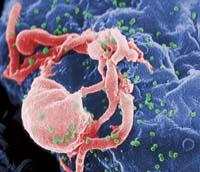The rebel HIV strategy, in evidence

The AIDS virus uses a more complex path than they believed to access the inside of cells
So far, researchers considered that HIV is associated with the superficial cell receptor, which subsequently binds to the membrane and subsequently releases its contents into the cell. The virus RNA replicates then and in total it was believed that the process lasts about ten minutes. Now G of the University of Maryland. The team led by researcher Melykan has shown that the intracellular penetration process is much more complex.
According to researchers, when HIV binds to the receptor, some sacs of the cell (endosome) collect the virus. That is, endocytosis occurs and endosomes isolate the virus for half an hour from the cell cytoplasm. Subsequently, the external layer of the virus joins the endosome membrane, getting the virus to release its contents to the cytoplasm.
In addition, inhibitors that prevent HIV infection have been studied and it has been proven that if they block an enzyme (dinamine) involved in endocytosis, HIV cannot infect the cell.
The research has been published in the scientific journal Cell. Researchers hope it will be useful in developing effective drugs for AIDS treatment in the early stages.
Buletina
Bidali zure helbide elektronikoa eta jaso asteroko buletina zure sarrera-ontzian











